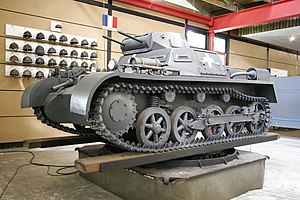Panzerkampfwagen I
| Panzerkampfwagen I | |
|---|---|

Panzerkampfwagen I Ausf. A on display at the Deutsches Panzermuseum Munster, Germany
|
|
| Type | Light tank |
| Place of origin | Nazi Germany |
| Service history | |
| In service | 1934–1945 |
| Used by | Nazi Germany, Bulgaria, Republic of China, Hungary, Spain |
| Wars | Spanish Civil War, Second World War, Second Sino-Japanese War |
| Production history | |
| Designed | 1934 |
| Manufacturer | Henschel, MAN, Krupp, Daimler |
| Produced | 1934–1938, 1943 |
| No. built |
1,659 as light tanks |
| Specifications | |
| Weight | 5.4 tonnes (6.0 short tons) |
| Length | 4.02 m (13.2 ft) |
| Width | 2.06 m (6.8 ft) |
| Height | 1.72 m (5.6 ft) |
| Crew | 2: commander and driver |
|
|
|
| Armor | 7–13 mm |
|
Main
armament |
2 × 7.92 mm MG13 machine guns |
| Engine | Krupp M 305 four-cylinder air-cooled gasoline engine 60 PS (59 hp, 44 kW) |
| Power/weight | 11.1 PS (8.1 kW)/t |
| Suspension | Quarter-elliptical leaf spring suspension. |
|
Operational
range |
200 km (120 mi) on-road; 175 km (109 mi) off-road. |
| Speed | 50 km/h (31 mph) on-road; 37 km/h (23 mph) off-road. |
1,659 as light tanks
184 as command tanks
445 as training tanks
The Panzer I was a light tank produced in Germany in the 1930s. The name is short for the German Panzerkampfwagen I ("armored fighting vehicle mark I"), abbreviated PzKpfw I. The tank's official German ordnance inventory designation was SdKfz 101 ("special purpose vehicle 101").
Design of the Panzer I began in 1932 and mass production began in 1934. Intended only as a training tank to introduce the concept of armored warfare to the German Army, the Panzer I saw combat in Spain during the Spanish Civil War, in Poland, France, the Soviet Union and North Africa during the Second World War, and in China during the Second Sino-Japanese War. Experiences with the Panzer I during the Spanish Civil War helped shape the German Panzerwaffes' invasion of Poland in 1939 and France in 1940. By 1941, the Panzer I chassis design was used as the basis of tank destroyers and assault guns. There were attempts to upgrade the Panzer I throughout its service history, including by foreign nations, to extend the design's lifespan. It continued to serve in the Spanish Armed Forces until 1954.
The Panzer I's performance in combat was limited by its thin armour and light armament of two machine guns. As a design intended for training, the Panzer I was not as capable as other light tanks of the era, such as the Soviet T-26. Although weak in combat, it formed a large part of Germany's tank forces and was used in all major campaigns between September 1939 and December 1941. The small, vulnerable light tank would be surpassed in importance by other German tanks, such as the Panzer IV, Panther, and Tiger; nevertheless, the Panzer I's contribution to the early victories of Nazi Germany during World War II was significant. Later in that war the turrets of the then obsolete PzKpfw Is and PzKpfw IIs were repurposed as gun turrets on specially built defensive bunkers, particularly on the Atlantic Wall.
...
Wikipedia
